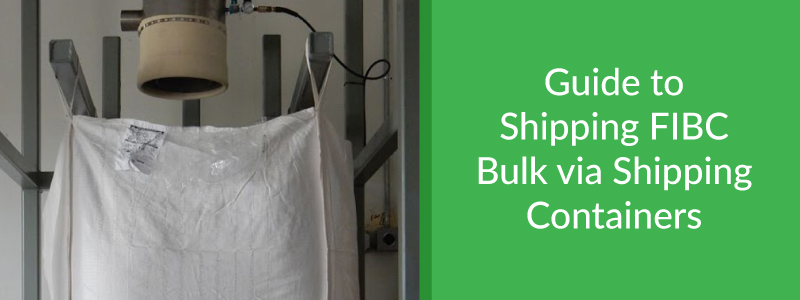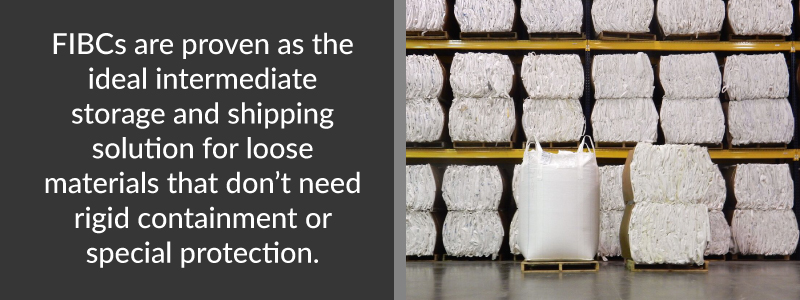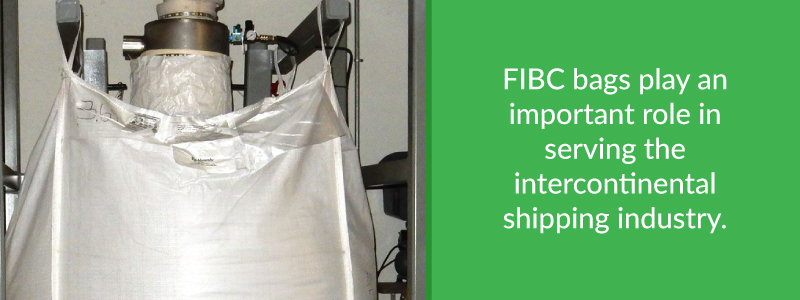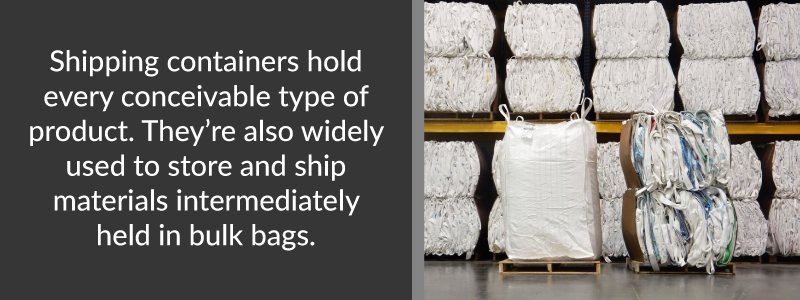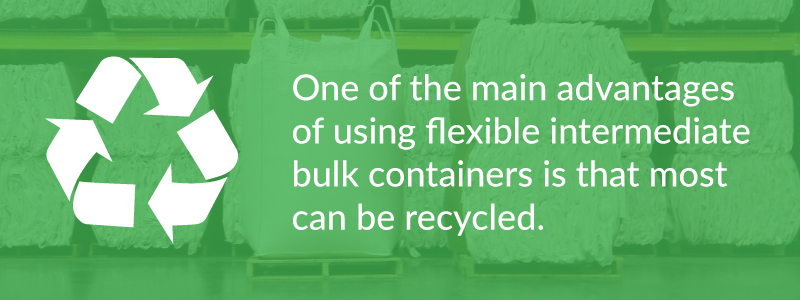Guide to Shipping FIBC Bulk via Shipping Containers
Flexible intermediate bulk containers, or FIBCs, are today’s preferred choice for bulk shipping dry particulate materials. Also called bulk bags or big bags, FIBCs are the perfect containers for storing and shipping a wide variety of products. They’re used everywhere from cement powder plants to coffee plantations, being transported by trucks, trains and planes. They’re also the perfect stowage solution for overseas ships and intermodal containers.
FIBCs are industrial containers designed for securing and transporting flowable goods that lend themselves to taking malleable shapes. They’re made of flexible fabrics, normally woven polypropylene or polyethylene. Both are crude oil byproducts that are safe, clean and extremely cost-effective. They’re also recyclable.
FIBCs have many advantages over rigid containers. They’re capable of holding tremendous volume, especially relating to their own weight. For the shipping industry, that’s vital as the cost of a container’s dead weight is factored into the overall transportation bill. Bulk bags are also extremely easy to handle. They load and unload by slinging from built-in straps with a machine, thereby saving manual labor. That makes FIBCs safer than other heavier, solid product containers.
These big bags have been around for a while, but they’re gaining increased recognition as the ideal compromise for bulk shipping goods. They make the highest use of valuable space in ship holds and standardized shipping containers. FIBCs were invented in the 1940s, when World War II goods needed efficient intermediate international transportation. They were originally made of PVC rubber, but this was replaced by flexible fabrics as technology advanced.
Flexible Intermediate Bulk Container Designs
FIBC designs have also evolved over the years. Though the principle remains the same, their shapes and specific purposes have molded to suit individual companies and the exact products they’re placing in bulk bags. There are four main FIBC categories for different materials.
- Open-top bulk bags: These FIBCs are the simplest design. They were also the first to appear on the FIBC scene. They’re like giant shopping bags that remain open in the upper portion and have two or more loops or handles for lifting and placing the loaded contents.
- Duffle-top bulk bags: Duffle bags’ upper portion can be closed with a drawstring, just like a regular duffle bag. These closed-top FIBCs are ideal for very loose materials that would tend to escape open-top variations.
- Spout-top bulk bags: As their name suggests, these specialized FIBCs have built-in spouts. This makes filling granular materials far easier than placing them into open or duffle-top bulk bags. Cement powder and granular fertilizer are normally placed in spout-top FIBCs.
- Baffle bulk bags: FIBCs with internal baffle partitions are the perfect solution for keeping loose material contained in a solid mass. Baffles establish specific zones inside the FIBC and allow them to stand without slumping into a shapeless mass. Baffle bulk bags stack well and are ideal for placing in large holds or intermodal containers.
FIBCs Serve Many Industries
FIBCs are used worldwide in many different industries. They’ve proven as the ideal intermediate storage and shipping solution for loose materials that don’t need rigid containment or special protection. They gained late 20th-century global acceptance when the Middle East oil industry rapidly expanded. Large amounts of cement powder were urgently needed for large-scale construction projects.
FIBCs were the right answer. They allowed huge quantities of powder to be cheaply contained and transported without the need for heavy, solid tanks. Bulk bags were easy to handle, weighed little and were easy to reuse or dispose of when empty. Since then, FIBC popularity soared, with many other industries recognizing bulk bag benefits. Other industries that take advantage of FIBC shipping and intermediate storage include:
- Chemical manufacturers
- Construction materials like gravel and sand
- Fertilizer suppliers
- Fiberglass handling
- Food producers
- Grain growers
- Hazardous material disposal
- Peanut farms
- Pharmaceutical companies
- Seed suppliers
- Solid pigment makers
- Starch and flour mills
Electrical Hazards With Flexible Intermediate Bulk Containers
Although flexible fabric bulk shipping bags are the perfect solution for many intermediate storage and shipping applications, their major drawback is static electricity. This presents a dangerous situation, especially when the FIBC is required to hold hazardous materials that react to sparks from static electric charges. Fortunately, the FIBC industry responded by sorting flexible bulk bags into four rating categories.
- Type A: These FIBCs have no static electricity safety features.
- Type B: Bags with Type B ratings can’t generate brush discharges over four kilovolts.
- Type C: Type C FIBCs are made from conductive fabric that serves to ground the contents.
- Type D: Anti-static properties are built into the fabric, which absorbs electric energy without grounding.
Theses anti-static capabilities might not seem important where FIBCs are stored or transported in open conditions. But they’re highly necessary when FIBC bulk bags are loaded with reactive materials and placed in tight enclosures like shipping containers and vessel stowage holds.
General Stowage Solutions for Overseas Shipping
Several inventions revolutionized the bulk shipping industry. One is the sea-going bulk shipping freighter. Another is the intermodal shipping container. And the third is the flexible bulk shipping bag. Combined, all three have made transcontinental ocean shipping efficient and economical.
FIBC bags play an important role in serving the intercontinental shipping industry. They’re ubiquitous at every world port and on every type of freighter vessel. To say FIBCs are an essential solution to bulk shipping is an understatement. But there is a process to properly loading, transporting and unloading big container bags.
It’s important to look back at how the overseas shipping industry started, and how we first made good use of bulk bagging methods. Historically, sea-going ships opened international trade around the world. By the 1500s, European sailors were navigating uncharted waters searching for valuable foreign trade commodities. Cargo sailing vessels were designed with large holds to stow or store bulk goods.
Labor was inexpensive back then. Sailors were paid like slaves, and they performed back-breaking manual labor as they hauled containers to and from stowage. They used hoisting methods, but once inside holds, containers had to be shuffled about by hand. That limited bulk container size and restricted designs to rigid boxed crates and round barrels. There was an economical and highly efficient exception — the sack.
Flexible Intermediate Bulk Containers Evolved From Burlap Sacks
Burlap sacks have been used for hundreds of years to contain, store and ship loose materials. They still are the most popular container for commodities like cocoa and coffee. Fifty-pound sacks or bags were the ideal answer for sailors and longshoremen to handle manually. They also stacked well and could be tightly crammed into vacant spaces. These flexible bags made highest and best space efficiency.
Shipping bags are more popular now than ever. The shipping industry grew over the past four centuries, and today’s mega-vessels are capable of carrying massive amounts of goods. As vessel size increased, so did the bags. Now, flexible containers hold thousands of pounds and no longer lifted manually. Rather, FIBCs are slung with cranes and forklifts as they’re stowed and removed.
There’s no replacing bulk bags for stowage efficiency. FIBCs are stacked into tight holds and fill up every square foot as they compress, molding into each other. Baffle bags are the right solution for stacking flexible containers that need to be kept in one shape. Open-top bags are best suited for larger materials that keep their shape, while duffle tops and spout-filling bulk bags perfectly contain fine powders.
Flexible Intermediate Bulk Bags for Shipping Containers
Standardized shipping containers are also called intermodal containers. They’re also known as seacans, cargo or freight containers and ISO containers. Intermodal transportation allows goods to be packaged at one location, then delivered by any combination of truck, rail, air or ocean freighter system.
Shipping containers hold every conceivable type of product. They’re also widely used to store and ship materials intermediately held in bulk bags. Sea containers have a different purpose or application than below-deck ship stowage. The main advantage of using seacans to hold FIBCs is where they’re secured on the freight vessel.
When bulk bags are designated to be stored in holds, they’re normally set in place without any other type of container. There’s no need for it. The vessel serves as the container, and bulk bags serve as intermediate, direct containment for whatever material is inside. Ship holds are dry and protected from the weather. The only time bulk bags are exposed is when they’re being installed or removed from stowage.
Sea containers are a different environment. Seacans are exposed to the weather. That’s when they’re on a flat-deck truck, piggybacked by rail or hoisted onto a cargo ship deck. Usually, sea containers remain on the deck and cross international waters under the threat of storms and torrential downpours. FIBCs stored inside ISO containers are perfectly safe and remain dry, as long as they’ve been properly loaded.
Pros and Cons of Loading Bulk Bags Into Shipping Containers
Sea containers are virtually everywhere. They go by on trains as they pass across the countryside. They wheel down interstates and along rural roads. Seacans sit exposed on warehouse lots and at oceanfront docks waiting international movement. There’s no telling what’s inside a seacan. Many of them contain fully loaded flexible bags.
Security and safety are a beautiful part of containerized shipping. Sea containers play multi-roles and have a general purpose. That’s different for FIBCs. They’re specialized containers for specific duties. But often, seacans are the perfect accompaniment to housing flexible bags. These are the pros and cons of combining sea containers and flexible bulk bags.
Pros for using bulk bags in shipping containers include:
- Securely holding material contents. Goods and raw materials best suited to be intermediately contained in bulk bags are loose by nature. Flexible bags are excellent at containing granular material, but can do little to protect them from outside forces.
- Keeping materials dry. Most materials suitable for bulk bagging can’t get wet. Water is devastating to products like cement powder and grain. Seacans are the perfect weather protection for bulk bag products that can’t be placed directly in the seacan
- Safely storing products. Sea containers can be locked and sealed to prevent theft and vandalism. Keeping FIBCs safe also prevents them from cross-contamination, which can ruin the products or different materials stored nearby.
Cons of using FIBCs in shipping containers are:
- Multiple movements. Products need original placement into bulk bags then require multiple movements in and out of sea containers. This costs time and money.
- Wasting space. It’s difficult to cram loaded bulk bags into sea cans. Their head space is limited, unlike ship holds.
- Added load weight. Shipping charges are calculated by a combination of weight and distance. Storing FIBCs in sea containers adds to the overall transportation weight, which drives expenses up.
Tips for Safely Transporting Containers by Sea
Ocean-going ships have faced the same perils throughout the history of transcontinental shipping. While containerized shipping is somewhat new, the art and skill of safe sailing isn’t. Freighters are exposed to dangerous weather hazards like hurricanes and high waves. They experience geographic hazards such as tight passages and port entries. They have technological hazards, including their navigation and communication systems. There are also human-caused risks, because sailors are people and make mistakes.
The sinking of the Titanic was a tragedy, but it had a positive outcome. The disaster forced a global effort to improve safety at sea. That led to uniform navigation rules and a vast change in safe shipping practices. It also affects how sea containers are loaded and secured on ships. Here are the best tips for safely transporting containers at sea:
- All materials must be tightly packed and supported inside containers. This prevents load shifting during rough sea conditions.
- Heaviest materials must be placed on the lowest level, with lighter goods on top. This includes flexible intermediate shipping bags.
- FIBCs must never be placed against sharp objects. Tears and punctures can damage or destroy valuable contents.
- Heavy loads must be evenly distributed throughout the seacan. This stops point loading that can cause structural failure.
- Wet or liquid materials also must be fixed on lower levels. Dry goods placed above are less likely to get wet if there’s a leak.
- Toxic goods must never be stored with others that could react. That could be electrical, chemical or flammable incidents.
- Goods must be secured by a net or gate before the end doors are closed. This stops accidental spillage when unloading begins.
- Seacans must be firmly attached to the ship deck. That depends on the vessel, but could include bolts, straps or bands.
- Sea containers must be clearly identified with a code. This allows industry officials to know the contents and destination.
Flexible Intermediate Bulk Containers Are Recyclable
One of the main advantages of using flexible intermediate bulk containers is that most can be recycled. FIBCs can be reconditioned and returned to service after careful cleaning and repairing flaws. This service results in excellent economics, not to mention environmental benefits.
Bulk Bag Reclamation is an essential service company in the flexible intermediate bulk container industry. Our management team combines 25 years of intensive experience to make sure bulk bags are properly reclaimed and returned to the shipping and storage industry. Our huge inventory includes the highest quality reconditioned open-top, duffle, spout and baffle bulk bag containers.
We work with the international shipping industry to make sure flexible bulk intermediate containers are safe and suitable, whether they’re stacked in ship holds or stuffed in sea containers. We ensure the right type of static electricity protection. We also ensure the size, strength and containment method is right for each product type.
For more information on flexible intermediate bulk containers, call Bulk Bag Reclamation at 515-444-7243. We’re ready to help you safely and securely contain your bulk products. You can also drop us a note through our online contact form.

